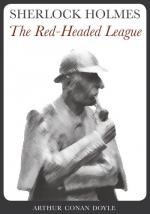|
This section contains 256 words (approx. 1 page at 400 words per page) |

|
The Red-Headed League Summary & Study Guide Description
The Red-Headed League Summary & Study Guide includes comprehensive information and analysis to help you understand the book. This study guide contains the following sections:
This detailed literature summary also contains Bibliography on The Red-Headed League by Arthur Conan Doyle.
"The Red-Headed League" first appeared in a popular British magazine, the Strand, in August of 1891. It was republished in 1892, along with eleven other Sherlock Holmes stories, in the collection The Adventures of Sherlock Holmes. Its style and structure make it a nearly perfect example of the modern detective story, first devised by Edgar Allan Poe fifty years previously. Doyle's ingenious plots and captivating central characters, Holmes and his sidekick Watson, brought the author literary success in his own time. Further, the Sherlock Holmes stories provided later writers with models for their own work. The existence of today's popular detective tales, whether in the form of books, movies, or television shows, are in large part due to Doyle's influence.
Many readers enjoy matching their wits against Sherlock Holmes, trying to see if they can solve the mystery along with him. This is usually a task doomed to failure because of the first-person narrative style, in which the detective's less-intelligent friend Watson tells the story and is as amazed as any reader when the detective reveals his solution.' "The Red-Headed League," like Doyle's other detective stories, presents a detailed portrait of turn-of-the-century London and gives readers glimpses of a society undergoing rapid change. Among these changes are alterations in the class structure, Britain's rise as a world economic power, and urban growth—along with a rising crime rate. As he attempts to restore a social order threatened by criminals like those in "The Red-Headed League," Sherlock Holmes embodies the values of intelligence and individual achievement.
Read more from the Study Guide
|
This section contains 256 words (approx. 1 page at 400 words per page) |

|



